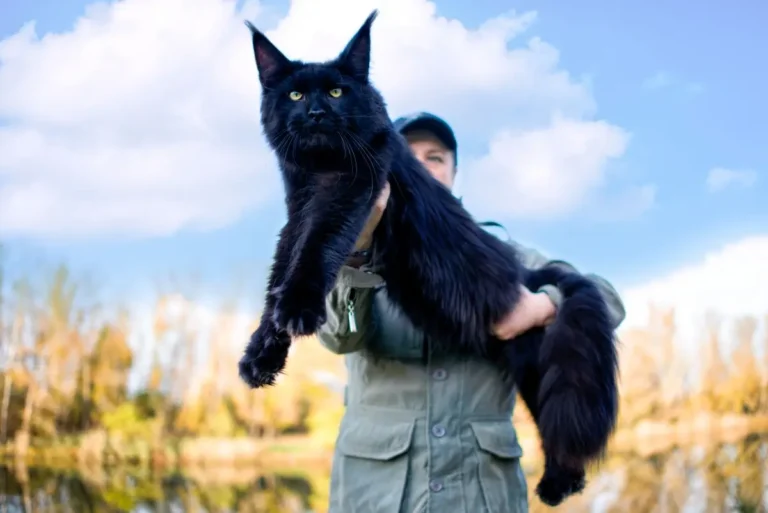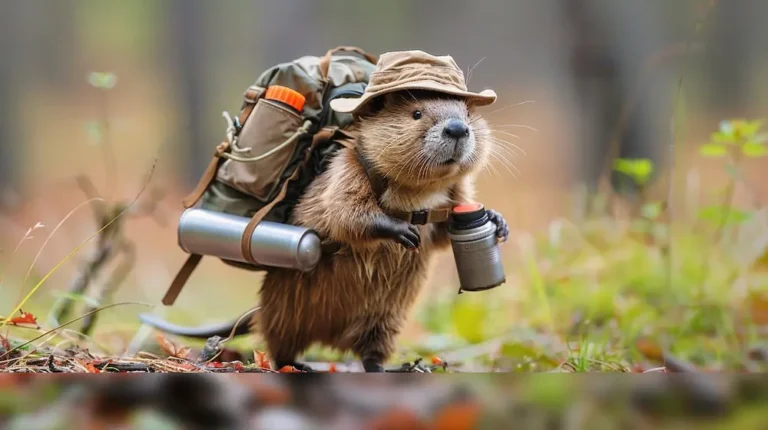🦒 Giraffe Wonders Await! 🦒 Ever gazed at giraffes and wondered what makes these towering giants so unique? From their extraordinary necks to their fascinating spots, giraffes are full of incredible and delightful secrets.
Join us as we explore a collection of fun and surprising facts about these gentle giants that will elevate your admiration for the tallest mammals on land! 🌟🌿📏
Interested in other animals, check out our curated list for more fun facts about animals.
Giraffe Anatomy and Physiology
- Giraffes have a long, prehensile tongue that can be up to 21 inches (53 cm) long. The tongue’s dark color helps protect it from sunburn.
- A giraffe’s neck alone is 6 feet (1.8 m) long and has the same number of vertebrae as a human neck (seven).
- Giraffes have a very high blood pressure (nearly double that of humans) to pump blood up their long necks to their brains. They have a specialized system of valves, complex pressure-regulation mechanisms, and thick-walled veins to manage blood flow.
- A giraffe’s heart can weigh up to 25 lbs (11 kg) and pump 16 gallons (60 liters) of blood per minute.
Giraffe Behavior and Social Structure
- Giraffes are herbivores and spend most of their day feeding. An adult giraffe can consume 75 lbs (34 kg) of food per day.
- Male giraffes establish dominance through “necking” – using their long necks to swing at and hit each other. The winner is the giraffe that can withstand the most blows.
- Giraffes are social animals and live in loose-knit herds. A group of giraffes is called a tower, herd or journey.
- Giraffes are known to sleep very little, only about 4.6 hours per day on average. They usually sleep standing up and rarely lie down.
Giraffe Conservation Status
- Giraffe populations have declined by 40% over the past 30 years. There are only about 111,000 giraffes left in the wild.
- Giraffes are classified as “Vulnerable” on the IUCN Red List of Threatened Species. Threats include habitat loss, civil unrest, and poaching.
- Conservation efforts are underway to protect giraffes, including anti-poaching patrols, habitat restoration, and community education programs.
So in summary, giraffes are remarkable animals adapted to their environment, with unique behaviors and social structures. However, their populations are threatened and conservation efforts are critical to ensure their survival.
Lets get to the fun facts about giraffes!
50 Fun Facts About Giraffes
1. Giraffes are the tallest mammals on Earth.
Adult males can reach heights of up to 5.5 meters (18 feet), while females can grow up to 4.3 meters (14 feet) tall. [National Geographic]
2. There are four distinct species of giraffes.
The Northern giraffe (Giraffa camelopardalis), Southern giraffe (Giraffa giraffa), Reticulated giraffe (Giraffa reticulata), and Masai giraffe (Giraffa tippelskirchi) are the recognized species. [Giraffe Conservation Foundation]
3. Each giraffe has a unique coat pattern.
Similar to human fingerprints, no two giraffes have the same pattern of spots, which helps researchers identify individuals. [Ultimate Kilimanjaro]
4. Giraffes have a long, prehensile tongue.
Their tongues can be up to 53 centimeters (21 inches) long and are dark blue to prevent sunburn while grazing. [ToucanBox]
5. A giraffe’s heart weighs about 11 kilograms (25 pounds).
This massive heart is specially adapted to pump blood up to its brain, which is about 2 meters (6.5 feet) above its heart. [Giraffe Conservation Foundation]
6. Giraffes can run as fast as 60 kilometers per hour (37 mph).
They can maintain speeds of around 10 kilometers per hour (6 mph) over longer distances. [National Geographic]
7. Giraffes have a unique way of drinking water.
They must spread their legs or kneel to reach the ground, as their necks are too short to reach directly. [National Geographic]
8. Giraffes only need to drink water once every few days.
They obtain most of their hydration from the leaves they consume. [DoSomething.org]
9. Female giraffes give birth standing up.
This causes the newborn calf to fall about 1.5 meters (5 feet) to the ground, helping break the amniotic sac and stimulating the calf to breathe. [Ultimate Kilimanjaro]
10. Giraffe calves can stand and walk within an hour of birth.
This ability is crucial for their survival in the wild. [San Diego Zoo]
11. Giraffes have a special adaptation in their jugular veins.
This adaptation allows them to manage blood pressure changes when bending down to drink. [Giraffe Conservation Foundation]
12. The giraffe’s ossicones are made of cartilage.
Both males and females have ossicones, but males typically have thicker ones. [ToucanBox]
13. Giraffes are social animals.
They often form loose herds called “towers,” which can include up to 15 individuals. [National Geographic Kids]
14. Giraffes have a specialized digestive system.
This system allows them to extract maximum nutrients from tough, fibrous leaves. [Giraffe Conservation Foundation]
15. They primarily feed on acacia leaves.
Giraffes can consume up to 45 kilograms (100 pounds) of foliage in a single day. [National Geographic]
16. Giraffes have large, expressive eyes.
Their excellent eyesight allows them to spot predators from great distances. [Ultimate Kilimanjaro]
17. Giraffes can sleep both standing up and lying down.
However, they typically sleep for only short periods, totaling about 4.6 hours per day. [Giraffe Conservation Foundation]
18. The giraffe’s coat helps regulate its body temperature.
The large patches of skin are surrounded by a network of blood vessels that release excess heat. [Ultimate Kilimanjaro]
19. Giraffes communicate using a variety of sounds.
They produce grunts, snorts, and hisses, although they are generally quiet animals. [National Geographic Kids]
20. Giraffes are known for their “necking” behavior.
Males swing their necks to strike each other in combat for dominance or mating rights. [Ultimate Kilimanjaro]
21. Giraffes have a unique adaptation in their legs.
The skin is tight, acting like compression socks to help blood return to the heart. [Giraffe Conservation Foundation]
22. Giraffes can live up to 25 years in the wild.
In captivity, some individuals can reach 40 years of age. [National Geographic]
23. Giraffes can be found in various habitats.
They inhabit savannas, grasslands, and open woodlands throughout Africa. [Giraffe Conservation Foundation]
24. Giraffes have a unique method of thermoregulation.
Their large ears help dissipate heat, acting like radiators. [Ultimate Kilimanjaro]
25. Giraffes are herbivores.
They have a specialized set of teeth that allows them to strip leaves from branches effectively. [Giraffe Conservation Foundation]
26. Giraffes have a relatively low reproductive rate.
Females typically give birth to one calf every 15 months. [National Geographic]
27. The Masai giraffe has jagged-edged patches.
In contrast, the Reticulated giraffe has a more defined, net-like pattern on its coat. [Giraffe Conservation Foundation]
28. Giraffes can reach heights of up to 19 feet.
This makes them the tallest land animals on the planet. [National Geographic]
29. Giraffes can deliver lethal kicks to predators.
Their powerful legs are effective for self-defense against threats like lions. [Ultimate Kilimanjaro]
30. Giraffes engage in social grooming.
They use their tongues to clean each other’s necks and bodies. [Giraffe Conservation Foundation]
31. The giraffe’s heart is about the size of a small car.
It weighs around 11 kilograms (25 pounds). [Giraffe Conservation Foundation]
32. Giraffes have a very low vocalization frequency.
This means they can communicate without alerting predators. [National Geographic Kids]
33. Giraffes have a special adaptation in their eyes.
They can see in color, which helps them identify ripe fruits and leaves. [Giraffe Conservation Foundation]
34. Giraffes are known to be curious animals.
They often investigate new objects or creatures in their environment. [Ultimate Kilimanjaro]
35. Giraffes can travel long distances in search of food.
They can cover up to 20 kilometers (12 miles) in a day. [Giraffe Conservation Foundation]
36. Giraffes have a unique way of walking.
They move both legs on one side of their body and then both legs on the other side, a gait known as “pacing.” [National Geographic]
37. The giraffe’s long neck provides a height advantage.
This allows them to spot predators from afar. [Giraffe Conservation Foundation]
38. Giraffes have a relatively small brain compared to their body size.
Their brains weigh about 600 grams (1.3 pounds). [Ultimate Kilimanjaro]
39. Giraffes are classified as vulnerable.
Their populations are declining due to habitat loss, poaching, and other threats. [IUCN Red List]
40. Giraffes can be seen flapping their ears to release heat.

This behavior helps them cool off in hot weather. [Giraffe Conservation Foundation]
41. Giraffes can be found in both protected areas and unprotected regions.
However, their populations are declining in many areas due to human activities. [National Geographic]
42. Giraffes have a strong maternal instinct.
Mothers often stay close to their calves for protection. [Ultimate Kilimanjaro]
43. Giraffes engage in playful behavior.
They can often be seen running and kicking, especially among younger individuals. [Giraffe Conservation Foundation]
44. Giraffes have a thick layer of collagen in their skin.
This helps protect them against thorns and other hazards. [Ultimate Kilimanjaro]
45. Giraffes are often depicted in art and culture.
They symbolize grace, beauty, and the ability to see the bigger picture. [National Geographic Kids]
46. Giraffes have a relatively low metabolic rate.
This allows them to survive on a diet of low-nutrient leaves. [Giraffe Conservation Foundation]
47. Giraffes have a strong sense of smell.
This ability helps them detect food and potential threats from a distance. [Ultimate Kilimanjaro]
48. Giraffes are often the subject of conservation efforts.
Various organizations work to protect their habitats and ensure their survival. [Giraffe Conservation Foundation]
49. Giraffes can engage in “necking” to establish dominance.
This behavior is a crucial part of their social interactions, especially among males. [Ultimate Kilimanjaro]
50. Giraffes are an important part of their ecosystem.
They help maintain the health of their habitats by controlling vegetation growth through their feeding habits. [National Geographic]These fun facts highlight the unique characteristics and behaviors of giraffes, as well as the challenges they face in the wild. Each fact is supported by reputable sources, emphasizing the importance of giraffes in our ecosystem and the need for conservation efforts.






